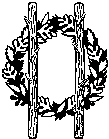















Druidic Symbols
Most world religions have a symbol which serves to represent that religion both for its adherents and for the outside world: the Cross or Crucifix of Christianity, the Star of David for Judaism, the Cresent and Star for Islam, the Eight-Spoked Wheel for Buddhism, etc. Neopagan and Pagan revival movements also have certain symbols: the three moons of Wicca, Mjollnir for Asatru, the fasces for Nova Roma, the Eye of Horus or Ankh for devotees of the Egyptian gods. With the exception of Wicca (being a special case), these symbols are based on real symbols from the Iron Age or earlier, when these religions were prominant.
Druidism, however, is in a bind when deciding on a universal symbol of the faith. This is due in large part for the lack of archaeological evidence for a universal symbol. Though some gods had a symbol associated with them--the triskele or triskelion of Manannan mac Lir, the sun wheel of Taranis--there is no universal symbol (to my knowledge) which can be found in all parts of the Celtic homelands, which represents Druidism as a whole. This is due to two factors:
Thus, modern Druidism (or neodruidism) has had to make its own symbols. The earliest symbol used to represent Druidism is the awen:
O The left ray represents man
O O The right ray represents woman
The middle ray represents the Divine
/ | \ The three dots are the three drops
/ | \ which fell on Gwion Bach's thumb
/ | \ causing his divine inspiration.
/ | \

This is also called "The Light of Three Rays." It seems to have been devised either by the hypothetical Llewelyn Sion in the sixteenth century, or the forger Iolo Morgannwg (his translator) in the 18th century. Either way, the earliest appearance of this representation of awen is in the spurious book Barddas, published in the early 19th century.
Its design has some precedent in the Kabbala's Tree of Life; the left ray is supposed to represent the masculine, the right ray the feminine, and the middle ray a union of the two. Most likely, Morgannwg was working with some knowledge of Kabbala (perhaps picked up from being a Freemason).
This design was then adopted by the mesodruidic community--those men (and I do stress "men") of the eighteenth century who used Druidism as part of a Welsh nationalist movement. It has survived through the modern era, and is somewhat accepted by most groups (especially the Order of Bards, Ovates, and Druids in Britain), despite its lack of "authenticity" and association with the Druidic Renaissance. This is likely due to the fact that it is easy to draw, and works upon a genuinely Celtic feature, the importance of the number three.
The second symbol used in Druidism is the "Druidic Sigil":

from Isaac Bonewitz's site
What we have are two lines--sometimes represented as sticks or logs--upon which is superimposed a circle--sometimes represented as a wreath. This symbol was first devised by David Fisher in 1963; it is the symbol for both the Reformed Druids of North America and the Henge of Keltria, two of the largest Druidic organizations in the United States. Supposedly, Fisher either based it on a the design of a temple in Stuart Piggot's The Druids (an excellent book, based on archeological and classical evidence, as opposed to the fantasies of past Celticists), or he simply made it up himself on the fly.
It is generally held to be a feminine symbol, reflective of the goddesses of Druidism.
Another symbol, used exlusively by Ar nDraioch Fein, is of a tree stump with a green shoot growing out of it. The obvious symbolism here is the revival of Druidism after both the Romans and Christianity had attempted to destroy it. The roots of the tree form a Celtic knot, which shows the groups Celtic roots, despite their Pan-Indo-European goals. A picture of it can be seen all over the ADF website:

A fourth symbol is used not so much to represent Druidism as a whole, but to act similarly to the (K) for kosher: the Beannaithe ag Draoithe ("Blessed by Druids") is a triskelion enclosed in a circle, and is meant to show that the object--food, medicine, statuary, religious tools--have been blessed by druids.
The symbols described can be found at Isaac Bonewits' site, along with the article "Symbols of Druid Identity", from which I have borrowed extensively.

Back to "D" | Back to JCE
Home
Mary Jones © 2004